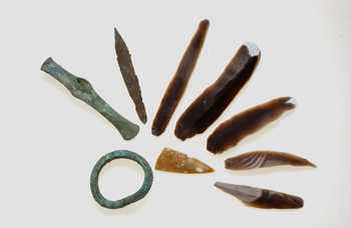Microhistory instead of bird’s-eye view
The study published by Zsuzsanna Siklósi and her colleagues, Norbert Faragó, János Dani, László Csedreki, Zsófia Kertész, Zita Szikszai, and Márton Szilágyi in the European Journal of Archaeology focuses on the Copper Age archaeological site Rákóczifalva-Bivaly-tó 1/C, located in the Central Tisza Region. The site was fully excavated between 2005 and 2007. The large-scale rescue excavation brought to light a Copper Age settlement and a contemporaneous cemetery found next to it. This circumstance made it possible to compare how the material culture appears in related, simultaneously used, but different archaeological contexts. This is an extremely rare situation in archaeology. Consequently, it sheds light on a methodological issue that the archaeological source material may have a distorting effect when we can solely rely on settlement or burial data. Additionally, it reveals the diverse forms of identity representation, which highly depend on the context.
In contrast to the macroregional approach, which is common in palaeoarchaeological research, Zsuzsanna Siklósi and her research team followed a bottom-up methodology starting with the individual, the smallest unit of society, during their research into Copper Age communities. Accordingly, they omitted the concept of archaeological culture, which is generally used as a unit analysis in palaeoarchaeological research.
The most important achievement of the study may be that it reveals a duality in the use of material culture, which is unprecedented in the research of the Early Copper Age in Hungary.
Despite the proximity in time and space, the finds discovered in the cemetery and settlement clearly demonstrate that the past community used the material culture at its disposal in very different ways in the two different contexts.
The finds yielded by the settlement clearly show that they come from the scene of daily life. The good-quality, beautifully decorated ceramics can be associated with household activities. The characteristics of the pottery style (the shapes and impressed decorations of the vessels) are suggestive of local traditions. There is no trace of the existence of long-distance connections in the settlement. For example, there is no evidence of the local processing of raw materials brought from distant lands. The finds discovered in the settlement reflect a high degree of homogeneity. No signs of social or other differences can be identified.
The finds discovered in the adjacent cemetery, which was contemporaneous with the settlement according to the radiocarbon data, show a completely different picture. The grave goods made from raw materials coming from great distances apparently had an important role in the cemetery. These included, for example, long blades made from Volhynian flint and copper objects produced in the area of present-day Serbia or Bulgaria based on their chemical composition. The gold pendants discovered in the graves also mirror a noteworthy difference compared to the settlement, where neither gold nor copper could be found. The stylistic analysis revealed that the ceramic vessels yielded by the cemetery also significantly differed from those found in the settlement.
Based on the grave goods, we can rightly assume the existence of social differences between individuals in terms of social gender, age, or rank.
The central feature in the cemetery is the symbolic burial discovered in the middle of the western group of graves, that is, a grave with furnishings but without human remains. The artefacts yielded by the burial attest to the long-distance relationships of the community that used the cemetery, since all kinds of such raw materials appear in it, except for gold.
The difference between the archaeological material discovered in the settlement and the cemetery, therefore, clearly reflects a high degree of consciousness on the part of this Early Copper Age community. These people identified themselves with different material cultures in two different contexts. It is also evident that the observation of this contrast was made possible by the bottom-up approach with which the archaeologists modelled the functioning of the prehistoric community starting with the smallest social unit of society (i.e., the individual). If they had created their model referring to archaeological culture as an a priori social entity, these dissimilarities could not or barely have been noticed.
The study that received the Faculty Publication Award can be read here.

